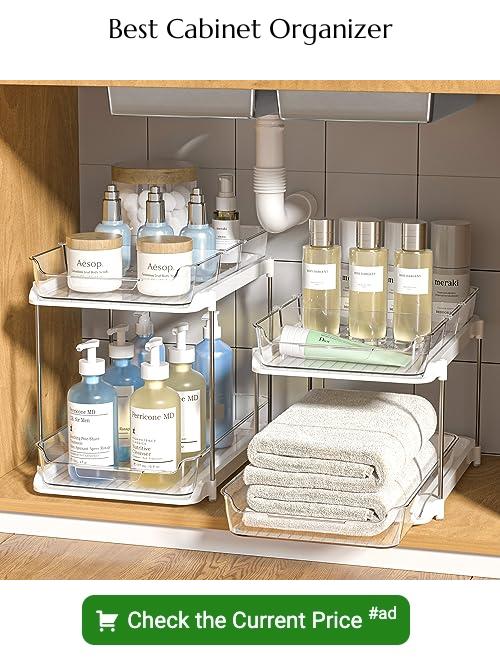Last updated on
Understanding standard cabinet sizes is vital for maximizing kitchen or bathroom storage space, and this article helps simplify the matter providing relevant insights and numerous examples to make your renovation planning easier.
Key takeaways:
- Measure base area: height, width, and depth (accounting for architectural features)
- Confirm wall cabinet width: measure the space, not just existing cabinets
- Check height and clearance: measure from countertop to bottom of upper cabinets
- Account for appliances and fixtures: precise cabinet measurements for seamless fit
- Double-check measurements: avoid costly mistakes by verifying twice
What's Inside
How to Measure Kitchen Cabinets

Navigating the measurement process is key to ensuring your kitchen cabinets fit perfectly in your space. Before you start, arm yourself with a tape measure, notepad, and a level.
1. Measure the Base Area: For base cabinets, check the height, width, and depth. Standard heights usually hover around 34.5 inches before countertops, and depths range from 24 inches. However, always account for moldings, trim, or any other architectural features that could impact the fit.
2. Confirm Wall Cabinet Width: Wall cabinets vary greatly, from 12 inches to 36 inches wide. It’s crucial to measure the space where the cabinets will hang, not just the existing cabinets, to consider any potential modifications or additional cabinetry.
3. Check the Height and Clearance: With an eye on usability, measure from the countertop or expected countertop height to the bottom of the upper cabinets. A common clearance is 18 inches, but this could change based on your needs.
4. Account for Appliances and Fixtures: Remember to measure accurately around any appliances or fixtures. Dishwashers, stoves, and sinks require precise cabinet measurements to ensure a seamless fit.
5. Double-Check Your Measurements: Nothing is more frustrating than cabinets that don’t fit. Verify your measurements at least twice to avoid costly mistakes.
Taking accurate measurements will lay the groundwork for a smooth installation process, avoiding delays and ensuring that your kitchen not only looks professional but functions flawlessly as well.
Base Cabinet Dimensions
Base cabinets are the workhorses of kitchen design, installed directly on the floor. They support your countertops, house your cookware and conceal appliances.
Typically, standard dimensions for these units are 24 inches deep and 36 inches tall, with width starting at 9 inches and increasing in 3-inch increments up to 48 inches. However, to accommodate for toe kicks, the base cabinet height is reduced to 34.5 inches, allowing for a 1.5-inch-high recess at the bottom.
To ensure a comfortable working height with standard countertops, which are 1.5 inches thick, these base cabinets ensure the surface is at an ideal 36 inches above the floor.
Corner base cabinets, designed to maximize space, usually have a front face of 17 inches along each wall, converging to form a right angle.
When planning, remember to leave clearance for doors and drawers to open properly, especially if there’s an island or appliances nearby.
If installing a sink base cabinet, widths range widely from 24 to 36 inches, to accommodate various sink sizes. Make sure to have the exact measurements of your sink or cookware beforehand to guarantee the right fit.
Kitchen Wall Cabinets Sizes
When selecting wall cabinet sizes, it’s critical to consider the ceiling height and the countertop clearance. Typically, these cabinets range from 12 to 17 inches in depth with the common depth being 12 inches to avoid obstructing work areas. In terms of width, they start at 9 inches and can go up to 48 inches, often in 3-inch increments to match different kitchen layouts and storage needs.
The standard height for wall cabinets depends on the distance between the countertop and the ceiling. A typical gap of 18 inches above the counter offers an optimal balance for ease of use and storage capacity. Wall cabinets usually start at a height of 12 inches and can reach up to 42 inches, often in 3-inch or 6-inch increments. This flexibility allows accommodation for various kitchen designs and user preferences.
It’s also worth noting that when installing over a refrigerator, a deeper cabinet, about 24 inches, is often selected to align flush with the front of the appliance, providing a streamlined look and maximizing accessibility. Selecting the right wall cabinet sizes is all about functionality and aesthetics, ensuring that they serve their purpose without overpowering the space.
Tall Cabinet Dimensions
Navigating the world of tall cabinet dimensions can be akin to selecting the perfect pair of jeans: precision is key. Usually found housing pantry items or sometimes integrating appliances like ovens, these cabinets stretch from floor to ceiling, maximizing vertical space.
Standard heights for tall cabinets range from 84 to 96 inches, often designed to accommodate ceiling height and leave room for trim work or a reveal. As far as width is concerned, expect a spectrum of 12 inches to 36 inches, providing options for slender broom closets all the way to expansive wardrobe-sized spaces.
Depth can be a bit of a chameleon, typically mirroring base cabinets at about 24 inches for those that integrate appliances but shaving down to around 12 to 18 inches for pantry use to keep everything within arm’s reach.
Remember, the more significant your cabinet dimensions, the more crucial it is to ensure your floors can embrace the weight. Furthermore, consider the swing of cabinet doors in your kitchen layout to maintain a harmonious flow and functionality.
Laying Out Your Kitchen – Tips and Tricks
Embarking on a kitchen layout design feels like a strategic game of Tetris—one where functionality and aesthetics duel for prominence. Optimizing your kitchen’s layout involves more than just fitting in standard-sized cabinets; it’s about crafting a space that meshes with your lifestyle and movement patterns.
First, consider the “work triangle” between your stove, refrigerator, and sink. These three points are the busiest in any kitchen, and a well-planned route between them can significantly enhance efficiency. Ideal distances are generally between 4 to 9 feet apart, creating a balance between easy reach and ample workspace.
Next, zone out your kitchen. Create distinct areas for different tasks: one for prepping, another for cooking, and perhaps a zone for gathering or dining. This zoning not only streamlines your workflow but also helps in deciding where to place different types of cabinets, from deep drawers for pots and pans to tall cabinets for pantry items.
Remember to account for the swing of doors and drawers. Plan for a clear path when these are open, ensuring that your kitchen doesn’t become an obstacle course when multiple cooks are working.
Include ample countertop space next to your major appliances. A landing area next to your fridge or oven allows for easy loading and unloading. This is where your measuring tape becomes your best friend, determining the right cabinet height and depth for these spaces.
And finally, lighting is paramount. Consider where natural light falls and where shadowy corners could use a boost. Well-placed under-cabinet lighting can illuminate countertops and make for a safer cutting surface.
By keeping these tips at the forefront, you customize your kitchen’s layout for efficiency, usability, and enjoyment—far beyond just fitting in standard cabinetry sizes.





